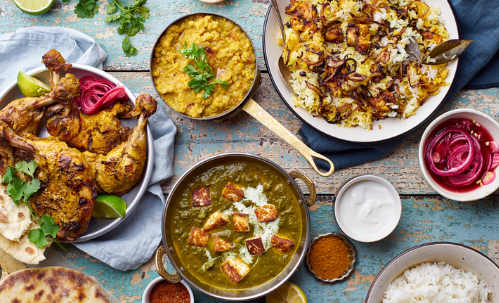A Taste of Pakistan: Exploring Traditional Desi Foods

Pakistan, a land of rich history and cultural diversity, is renowned for its vibrant culinary traditions. The cuisine of Pakistan is deeply rooted in the country’s history, influenced by Persian, Central Asian, and Mughal cooking styles. Spanning from the spicy curries of Punjab to the subtle, aromatic flavors of Sindh, every region contributes its unique essence to the country’s culinary tapestry. This article delves into the delectable world of Pakistan’s traditional desi foods, exploring the variety, flavors, and cultural significance of these iconic dishes.
Main Dishes: Hearty and Flavorful
Biryani
No discussion of Pakistani cuisine is complete without mentioning biryani. This iconic rice dish combines long-grain basmati rice with spiced meat, yogurt, and a host of aromatic spices like cardamom, cloves, and cinnamon. Originating in the Mughal kitchens, biryani is a must-have at weddings, festivals, and family gatherings. Karachi-style biryani, with its spicy kick, is particularly famous.
Nihari
A slow-cooked stew made from tender cuts of beef or mutton, nihari is another hallmark of Pakistani cuisine. It is cooked overnight to achieve its rich, velvety texture and served with naan. Garnished with ginger, green chilies, and lemon, nihari is a comfort food for many.
Haleem
Haleem is a labor-intensive dish prepared by simmering meat, lentils, wheat, and barley over several hours. The result is a thick, paste-like consistency bursting with flavors. It is especially popular during Ramadan and Muharram.
Karahi
Prepared in a wok-like pan, karahi is made with tomatoes, ginger, garlic, and green chilies. This versatile dish features chicken, mutton, or prawns and is a favorite at homes and roadside eateries alike.
Saag and Makki ki Roti
This rustic combination is a winter staple. Saag, made from mustard greens and spinach, is slow-cooked with spices and butter to enhance its flavor. It pairs perfectly with makki ki roti, a flatbread made from cornmeal.
Snacks and Street Food
Samosa
Deep-fried triangular pastries filled with spiced potatoes, lentils, or minced meat, samosas are a popular tea-time snack and a Ramadan favorite.
Gol Gappa (Pani Puri)
Crispy, hollow spheres filled with tangy tamarind water, chickpeas, and potatoes, gol gappa is a beloved street food that delivers a burst of flavor with every bite.
Chaat
A tangy and spicy medley of chickpeas, potatoes, yogurt, and chutneys, chaat is a versatile snack available in many regional variations.
Seekh Kebab
Minced meat mixed with a blend of spices is molded onto skewers and grilled over charcoal. Juicy and flavorful, seekh kebabs are a street food staple.
Bread and Rice: Staples with a Twist
Naan and Paratha
Naan, a leavened flatbread, and paratha, a flaky, buttery bread, are essential accompaniments to most curries. Parathas can also be stuffed with fillings like potatoes, minced meat, or cheese for a wholesome meal.
Zarda
A sweet rice dish made with sugar, cardamom, nuts, and dried fruits, zarda is often served at weddings and festive occasions.
Tahari
A simpler cousin of biryani, tahari is a yellow rice dish flavored with turmeric and often cooked with potatoes or lentils.
Desserts: Sweet Delights
Gulab Jamun
Soft, deep-fried milk balls soaked in sugar syrup, gulab jamun is a universally loved dessert. It is served warm or at room temperature.
Kheer
A creamy rice pudding made with milk, sugar, and cardamom, kheer is often garnished with nuts and saffron for added richness.
Gajar ka Halwa
A winter specialty, gajar ka halwa is made by slow-cooking grated carrots with milk, sugar, and ghee, then garnishing with nuts.
Jalebi
These orange, spiraled fritters are made by deep-frying flour batter and soaking it in sugar syrup. Jalebi is crispy, sticky, and utterly satisfying.
Beverages: Quenching the Thirst
Lassi
This yogurt-based drink is available in both sweet and salty versions. Lassi is a refreshing accompaniment to spicy meals, especially during summer.
Chai
A steaming cup of chai (tea) is integral to Pakistani culture. Brewed with milk, sugar, and sometimes spices, chai is a daily ritual for many.
Sherbet
From rose-flavored drinks to tangy lemon concoctions, sherbet is a refreshing treat, especially during Ramadan.
Cultural Significance
Food in Pakistan is more than sustenance; it is a cultural expression. Sharing a meal symbolizes love and unity, while the preparation of food often brings families together. From the elaborate meals served at weddings to the humble roadside stalls offering quick snacks, food is a binding force across communities.
Conclusion
Pakistan’s traditional desi foods are a testament to the country’s rich history and cultural diversity. Each dish tells a story, representing the local ingredients, techniques, and customs of the region it originates from. Whether it’s the aromatic biryani, the rich haleem, or the comforting saag and makki ki roti, Pakistani cuisine offers a sensory experience that is hard to match. Exploring this culinary treasure trove is not just about savoring flavors but also about immersing oneself in the soul of Pakistan.



